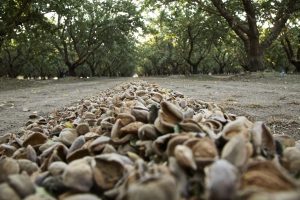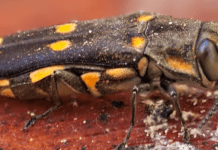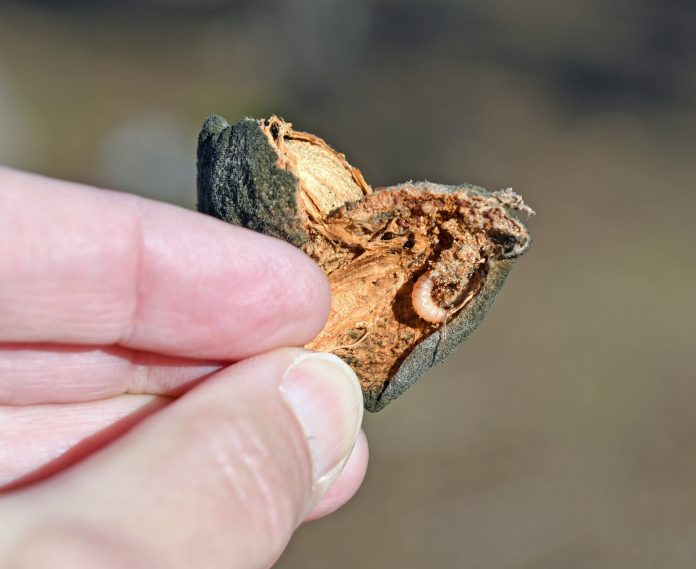
There is no ‘one and done’ for this pest.
Successful efforts to minimize navel orangeworm damage in almond crops comes down to these top five strategic steps: sanitation, monitoring, mating disruption, insecticide applications and timely harvest.
Navel orangeworm (NOW) is the primary insect pest of almonds in California. In the larval stage, it bores into nuts to feed, not only damaging the kernel but introducing molds that can produce aflatoxins.
The ability of navel orangeworm, Amyelois transitella, to fly long distances and feed on many different host crops makes control in tree nut crops a challenge. In devising a control program, growers need to consider the almond varieties in the orchard, anticipated harvest dates, NOW pressure levels as determined from pheromone trapping, overwintering mummy load and proximity to tree nut orchards with high NOW levels.
1. Orchard Sanitation
“Destroy with prejudice” is how Blue Diamond Grower Relations Manager Mel Machado advises almond growers to carry out orchard sanitation. Achieving good orchard sanitation can be difficult in wet years, but Machado said there really isn’t an alternative.
“This is the foundation of any control program. You cannot spray your way out of the NOW problem,” he said.
Unless orchard sanitation was done by early December, heavy rains since then may have kept growers from completing orchard sanitation. Depending on the variety, growers could have completed sanitation through the first week of February. Machado said research has shown that almond trees only keep 20% to 40% of fruiting buds, and if a few are lost with a late shake, yield loss potential is low.
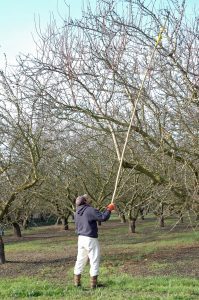
There should be no more than one to two mummy nuts left on the tree after the shake, Machado said. In areas where NOW pressure is higher, in south state growing regions, the threshold is even lower at half a mummy per tree.
“And no, crows won’t do the job for you,” Machado said.
Machado is a little more direct when addressing how the mummy nuts should be destroyed.
A flail mower operated at a speed where nuts are not just wounded but fully destroyed is recommended, removing protected overwinter sites.
Operation speed depends on the type of blades on the mower, how fast they are turning and the number of nuts on the ground. Machado advised picking a gear, mowing 50 feet and checking to see if the nuts are being destroyed. Slow down if nuts are not being completely destroyed.
This sanitation step can be carried out later than the shake, he said, as the NOW adults won’t emerge until April. Mummy degradation can be enhanced if they are shaken into a cover crop. The moisture in a green cover crop will increase mortality, Machado said, and when the crop is mowed prior to NOW emergence, the nuts can be destroyed.
Almond Board of California Principal Analyst Jesse Roseman noted that sanitation alone produces better control results than two hull split sprays.
2. Monitoring
Tracking phenology of NOW is the basis for treatment decisions. Considering costs of NOW control, Semios in-house PCA and Entomologist Abigail Welch said precise use of insecticides is paramount.
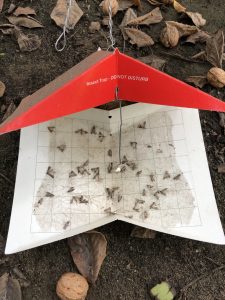
“When you are tracking phenology, you want to hit the targeted stage at the right time to be as impactful as possible,” Welch said.
Monitoring for NOW egg oviposition is important to set biofix, which initiates degree day accumulation for that flight. This is achieved using egg traps early in the season to monitor the activity of mated female NOW. Baited wing traps can also be used to attract mated females. Pheromone traps are used to monitor adult male NOW activity but are less informative when mating disruption systems are in use. Phenyl proprionate (PPO) lures can be used with pheromone lures or nutmeal lures can be used to monitor adults under mating disruption.
Welch said the first-generation cycle from egg to adult is completed in 1100 degree days because they are feeding on mummy nuts. The second generation completes a cycle faster; in 700 degree days given the eggs are laid on fresh nut material after hull split. This can cause a difference in when the subsequent flights will emerge, and the differences in hull split timing between almond varieties can present challenges in timing insecticide applications.
3. Insecticide Applications
This part of NOW control is most effective when done at the right time. USDA Research Entomologist Joel Siegel said planning ahead and preparation will allow sprays to be initiated and completed at the right time.
“Buy your chemicals early, not the week before you plan to spray,” Siegel advised. With the difficulty in obtaining products in the last two years, it would be a good idea to get orchard chemicals as early as possible.
It is also important to make insecticide applications as efficient as possible. Correctly calibrating sprayers and replacing worn nozzles improves efficiency. Siegel also advised following the insecticide label and adding an adjuvant as well as reading its label.
Listening to and following recommendations of your PCA is also important. Siegel said when the recommendation is to spray July 1 and the application isn’t made until five days later, efficacy is lost. Even if the start time is on target, finishing the job in five to seven days is important. Siegel said if that cannot be done, consideration should be given to air application or adding more equipment. To achieve maximum return on spray costs, he said to spray both sides of the tree row at a speed that allows for canopy coverage.
“If ground speed is too fast, you sacrifice ability to achieve good coverage in the upper canopy,” Siegel said.
Siegel also recommended evaluating spray crew abilities and designating the most responsible person to mix the tank batches and pre-position the material in the orchard when possible, decreasing down time for the spray rig.
There are lots of good reasons to make insecticide applications at night, Siegel said, like less degradation of chemicals by UV rays, less evaporation and drift. Navel orangeworm moths are more active at night, so kill rate is higher.
4. Mating Disruption
Mating disruption (MD) in an orchard is a preventative measure meant to suppress NOW population. Used over time, MD has the potential to reduce need for insecticide applications.
Emily Symmes, senior manager of technical field services for Suterra, said growers who are considering adoption of this technology should speak with MD manufacturers to determine which products are the best fit for their operation.
Delivery systems for the pheromones used in MD include aerosol puffers, which are timed release, and passive release emitters that work over the entire season. The newer flowable products last 30 days after application and help with grower flexibility. Symmes said these can target specific NOW flights.
Regardless of the delivery system, Symmes said it is important to fit the system to the orchard.
There are systems that work in smaller orchards. Mating disruption can make an impact even if there is potential NOW migration into the orchard.
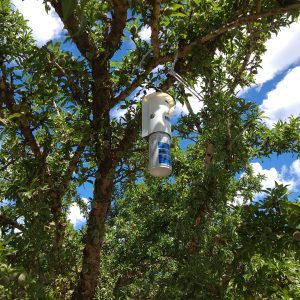
5. Timely Harvest
Almond harvest contractor and grower Matthew Efird said control of harvest timing is essential in getting the nuts out of the orchard before NOW damage occurs. Almond growers who have their own harvest machinery have more control when their trees are shaken and nuts picked up. Those who rely on a contractor need to monitor for NOW flights and make insecticide applications when necessary to prevent damage if harvest is delayed.
Almond variety, size of operation and weather are part of the decision-making process, Efird said. The goal is to get the nuts harvested before later NOW flights. The longer the nuts remain in the orchard, the greater the risk of damage.
Risk of NOW infestation in early harvested varieties such as Nonpareil can be reduced if nuts are harvested before third-generation eggs are laid.
Efird said almonds are ready to shake when hulls are completely split and have a yellow coloring. The further the hulls are past that point of maturity, the more difficult the almonds can be to remove.
